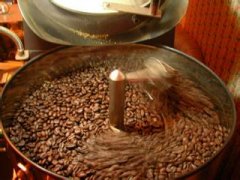Treatment of Coffee fruits-- washing
When the coffee fruit is harvested from the mountain, the next step is to remove the peel and pulp of the coffee beans. There are two main ways of treatment: washing and solarization. But the ultimate determining factor is whether there is enough water to use. Some special boutique coffees are both insolated and washed.
Washing requires the use of special machinery and equipment and adequate water sources. When properly treated, the special characteristics of coffee beans can be more highlighted. In addition, the number of bad beans can also be removed in large numbers during the washing process, so that the quality of coffee beans can be improved. The procedure of washing coffee is widely used in Central and South American countries.
After the coffee beans are harvested, they will first make a simple selection to remove impurities. After that, a truckload of trucks will carry the coffee beans into a large sink, and clean and flowing water will wash the coffee beans into the waterway. Ripe coffee beans should be dense and sink under the waterway. Damaged coffee fruits, branches, leaves, and lighter impurities float on the water surface and are isolated and removed by a filter above the waterway.
After being washed and sorted in the waterway, the pulp of the ripe fruit will be removed by the pulp remover. This step is the most different from sun-cured coffee, because the pulp and beans are separated before the sun.
At this time, the outer layer of the coffee bean is covered with a layer of sticky soft parchment, which can protect the integrity of the coffee bean. The washing process should be carried out immediately after the coffee is harvested to avoid taste contamination caused by pulp decay and the deterioration of the quality of the coffee beans.
After that, the coffee beans are placed on a mechanical strainer. The shaken strainer will separate the immature beans and bad beans that were not separated in the previous washing step. Successfully filtered coffee beans are put into the waterway for the second time and cleaned and sorted again with clean water.
Due to the peeling machine, there is bound to be some residual pulp still attached to the parchment of coffee beans. Coffee beans are then placed in a fermentation tank to decompose the residual pulp and parchment with natural enzymes. The fermentation process usually ends within 24-36 hours, depending on the temperature, the thickness of the residual pulp, and the concentration of enzymes. Next, the coffee beans will be washed with clean water until the pulp and parchment are removed. The fermentation process must be strictly monitored, otherwise, some bad sour taste or taste will be contaminated on the coffee beans. After processing, the surface of the coffee beans will become rougher and less sticky.
After fermentation and washing, the water content of coffee beans is about 57%. Due to the excessive moisture of coffee beans, the water content is usually reduced to 12.5% by machine drying or sun exposure. If you use machine drying, it usually takes 2-3 days to effectively reduce the water content to the ideal data. If you use the sun, you need the weather, and the relative time will be extended to 1-2 weeks.
When the water content of coffee beans is effectively reduced to 12.5%, the coffee beans will be stored for export. Finally, before the coffee is exported, the parchment and the last layer of silver will be removed by machine. Then, it goes through the steps of cleaning, screening, classification, classification, and packaging.
Washed coffee beans can make the coffee taste cleaner, free of miscellaneous flavors and have charming fruit aromas. The color of washed coffee beans will be more turquoise or grayish green. The coffee in the washing process tastes clear, bright and free of miscellaneous flavor.
Important Notice :
前街咖啡 FrontStreet Coffee has moved to new addredd:
FrontStreet Coffee Address: 315,Donghua East Road,GuangZhou
Tel:020 38364473
- Prev

Analysis of roasting steps of coffee beans
Coffee is loved by people mainly because of the aroma formed by roasting and the taste when drinking. The coffee raw bean itself does not have any special taste, but roasting completely changes and reorganizes the substances inside the raw bean to form a new structure, thus bringing out the mellow flavor of the coffee.
- Next

The treatment of Coffee Fruit-- Solar
The solarization process can also be called a natural process, which is basically the oldest, simplest, and requires the least mechanical tools.
Related
- What is the meaning of lactic acid fermentation with coffee bean treatment?
- How to judge the state of foam by sound?
- How does the latte pull out the unicorn pattern? Come to get for a little trick to improve the flower pull!
- Will flower pulling affect the taste of the latte?
- Do you know the history of coffee?
- The difference between honey treatment and sun washing what is raisin honey treatment?
- What kind of milk can a novice use to make coffee foam to keep the foam longer? The correct method and skills of milking tutorial sharing
- Why do washed coffee beans taste sour? Flavor characteristics of washed Coffee
- Introduction to the skill of how to practice the size and height of water injection around the circle of hand-brewed coffee
- How do beginners practice coffee flower drawing from scratch?

